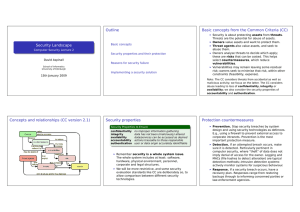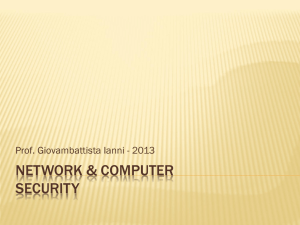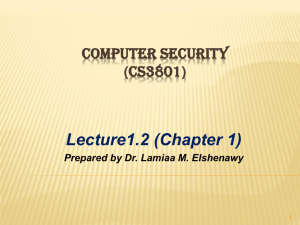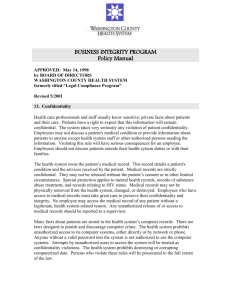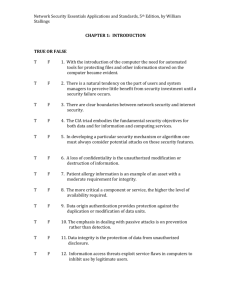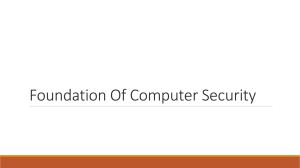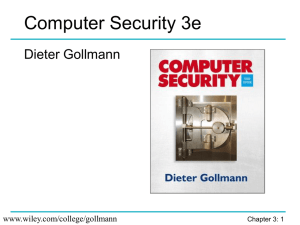Lecture 1
advertisement
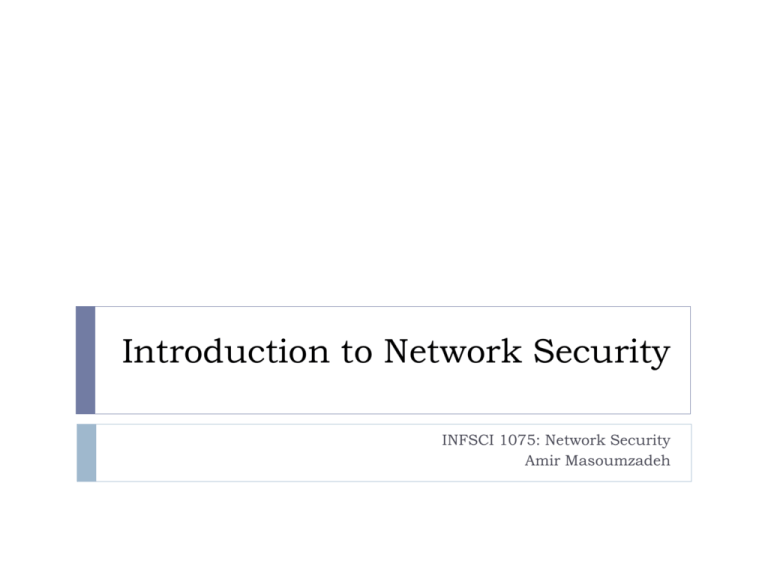
Introduction to Network Security INFSCI 1075: Network Security Amir Masoumzadeh Survey Results Count: 23 Other courses: 4 Individual vs. group labs: 0.44 TCP/IP: 6 / 10 Crypto: 1.5 / 10 Technical vs. general: 0.47 Office hours: Tue.-PM (9) vs. Wed.-PM(8) It remains as set before: Tue. 2pm-4pm Term project:Yes(13) / Maybe (6) 2 Paper vs. development: 0.41 Outline What is network security? Why? Benefits of good security practices Approaches to network security Three Ds of security ITU-T X.800 Security Architecture for OSI Attacks vs. threats Security services Security mechanisms 3 Information Security: Yesterday’s goal vs. Today’s Information Security requirements have changed in the new digital economy Traditionally provided by physical and administrative mechanisms Information was primarily on paper, lock and key, safe transmission Control access to materials, personnel screening, auditing Blocking access to majority is no longer valid! Information Security today: enables businesses. Every company wants to open up its business operations to its customers, suppliers, and business partners! (e.g. Car manufactures) The more access you provide, the more people you can reach. (do more with less!) So, how information security enables businesses? 4 By automation of business processes, made trustworthy by appropriate security strategies and techniques! Information Security Today Deals with Security of (end) systems Security of information in transit over a network (Network security) 5 Examples: Operating systems, files in a host, records, databases, accounting information, logs, etc. Examples: e-commerce transactions, online banking, confidential emails, file transfers, record transfers, authorization messages, etc. What is Network Security? Protection of networks and their services from unauthorized modification, destruction, or disclosure, and provision of assurance that the network performs its critical functions correctly and there are no harmful sideeffects [INFOSEC-92] 6 http://www.cultural.com/web/security/infosec.glossary.html What is Network Security? (Cont.) Focuses mainly on different networks, network protocols, and network applications Includes all network devices and all applications/data utilizing a network (not just “computers”) Includes “Application Layer” vulnerabilities Includes Routers, Switches, Satellites, etc. Includes cellular phones, PDA's, MP3 players, browserenabled gadgets, etc. Even network cards or other computer hardware 7 What is Network Security? (Cont.) Security Protecting general assets Information Security Protecting information and information resources Network Security 8 Protecting data, hardware, software on a computer network What is Network Security? (Cont.) Network security is increasingly integrated with other security sub-disciplines Exploits that exist within applications Exploits that exist within operating systems Viruses & Worms (What’s the difference?) Vulnerabilities originating from the user Weak passwords Unsafe user practices (file-sharing, IM, etc.) Social engineering? 9 Getting employees to reveal sensitive information about a system Usually done by impersonating someone or by convincing people to believe you have permissions to obtain such information Or by incentives What is Network Security? (Cont.) Network security is not just about hacker attacks Data loss caused by mishandling, misuse, or mistakes Ensuring service availability 10 E.g. Loss of service can take a very large bite out of a company’s stock price! Bad reputation! Protection from negligent internal sources (e.g. file sharing) What is Network Security? (Cont.) Today, network security is viewed as prevention AND as an enabling mechanism Reduce business costs/expenses Provide new opportunities for revenue Enable new, faster, and more productive business processes Provide competitive advantage In some cases, documented security may be necessary to allow a business access to a certain market (e.g., Healthcare, Financial, etc.) 11 Why Network Security? (Past & Present) Security began with two opposed models Academic - Everything is open Government/Military - Everything is closed This changed as business and home users entered the world of networks and e-commerce Closed door is too restrictive, open allows for little or no protection Needed new model to provide limited/controlled access Today, security is much more complex 12 Enable valid users (at various levels) while keeping out intruders Benefits of Good Security Practices Looking at security only as an expense is a big mistake! Business Agility Technology centered business models demand access to data and back-end services Security allows an organization to selectively allow access to data This facilitates business processes 13 Information MUST flow (e.g. Car manufacturers again) Information sharing with peers and contractors Information analysis and assessment Control over information gives businesses a strategic advantage Benefits of Good Security Practices (Cont.) Return on Investment (ROI) What does security contribute to the company / individual? Two major components Risk Management (preventive aspect) – How much have we saved by avoiding attack? Business Contributions (Enabling aspect) – What does security enable? 14 Accept Risk Mitigate Risk Transfer Risk How has security benefited our business processes? What doors has security opened for our company? The Three Ds of Security Defense (instinctive and always precedes others) Deterrence (laws against violators) Reduces frequency of security compromises e.g., threats of discipline & termination for employees for violation of policies Detection Reduces likelihood of successful security compromises e.g., firewalls, ACLs, spam and virus filters, etc. Without that a security breach may go unnoticed for hours, days, or even forever e.g., auditing and logging, IDS, etc. All three must be applied! Defense Detection Deterrence 15 ITU-T X.800: Security Architecture for OSI Defines a systematic way of defining and providing security requirements For us it provides a useful, if abstract, overview of concepts we will study Breaks security down into security services and mechanisms Services – generic constructs designed to provide system/data security at a particular level Mechanisms – specific methods used to realize the services necessary to provide adequate system/data protection 16 A process that is designed to detect, prevent, or recover from attack Attack vs. Threat A threat is a “potential” violation of security The violation does not need to actually occur The fact that the violation might occur makes it a threat It is important to guard against threats and be prepared for the actual violation The actual violation of security is called an attack 17 Passive – attempts to learn or make use of information without affecting system resources Active – attempts to alter system resources and affect their operation Passive Attacks 18 Active Attacks 19 Security Services In general Measures intended to counter security attacks by employing security mechanisms Like physical procedures, but increasingly automated Examples - signatures, documents, ID cards, endorsements, etc. Typical services that are considered are confidentiality (privacy), authentication, integrity, non-repudiation, availability 20 Security Services (X.800) Authentication Access Control Messages/data are not modified in an unauthorized way Non-Repudiation The contents of a message/data are not disclosed to unintended parties Data Integrity Prevention of unauthorized use of a resource Data Confidentiality Makes sure that the communicating entities are the ones who they claim to be Protection against denial by one of the parties in a communication (sender/receiver cannot deny sending/receiving data) Availability 21 A resource should be accessible and usable by authorized users, on demand Confidentiality Information should be accessible only to authorized parties Related to “concealing” of resources or information It can be broad It can be narrow Including all possible data or the very existence of data Taking into account only certain fields or parts of the data Attacks are mostly passive 22 Interception leading to disclosure or traffic analysis Active attacks are also possible and increasingly common Authentication/Integrity Authentication Identity of the source of information is not false During initiation of connection During ongoing interaction Attacks are active – fabrication, masquerade, replay, session hijacking etc. Integrity Information has not been modified by unauthorized entities 23 Not reordered, inserted, delayed, or changed in any other way Attack is active: modification, alteration Integrity/ Non-repudiation Evaluating and assuring integrity is hard There are several issues Verifying that the source of the information is right Verifying that the source is trustworthy or credible How was the data protected before it arrived? How is the data currently protected? Where has the data passed through? Non-repudiation Neither the sender nor the receiver should deny the transmission or its contents 24 A user should not be able to deny that he created some files Another user should not be able to deny that he received a notification Availability/Access Control Availability Information is available to authorized parties when needed Threats to availability Important aspect of reliability and system design A system that is not available is as bad as no system at all There may be deliberate attempts to deny access to data and service or natural failures Patterns of usage can be manipulated to affect availability Access Control 25 Only authorized people have access to the network resources and information There may be varying levels of access and control Requires good policies to be in place Affects all other security services Security Services & Attacks Attack Service Release of message contents Traffic Analysis Masquerade Authentication X Access Control X Confidentiality Data Integrity X Replay Modification of Denial of Messages Service X* X X Nonrepudiation Availability 26 X Security Mechanisms Features designed to prevent, detect, and recover from a security attack No single mechanism that will support all services required However one particular element underlies many of the security mechanisms in use: Cryptographic techniques Hence our focus on this topic 27 X.800 Security Mechanisms Y Access Control Y Traffic flow confidentiality Y Data Integrity Y Availability 28 Y Y Confidentiality Non-repudiation Notarization Y Routing Control Data origin authentication Traffic Padding Y Authentication Exchange Y Data Integrity Peer entity authentication Access Control Digital Signature Encipherment Service Y Y Y Y Y Y Y Y Y Y Some Components of Network Security Assets – Some resources that have value Data, Bandwidth, Processing Power, Storage, etc. Risks – What can potentially happen to our assets? Vulnerability – A weakness that can be exploited. Threat – Someone or something capable of exploiting a vulnerability/asset. Protections – Mechanisms that can/will be used to protect assets (e.g., firewalls, policies, etc.) 29 Some Components of Network Security Tools – Programs/procedures that can be used to verify protections, discover risks, etc. Priorities – Dictates which tools will be used, how they will be used, and which assets need to be protected. Strategy – Definition of all the architecture and policy components that make up a complete plan for security. (Big pictures) Tactics – Day-to-day practices of the individuals, and technologies assigned to the protection of assets 30 Policies & Requirements Policy - a statement of what is allowed and what is not. It should take into account Often involves procedures that cannot be implemented solely through technology What resources are being protected Who may attack these resources (Risk) How much of security can be afforded (Cost) Human factor is very important Conflicting policies may exist Extremely important for legal recourse 31 Some Security Principles The “defense level” of various components should be equal (Equivalent Security) i.e., Security is only as strong as the weakest link Attack Vectors Protection Level Target There is no such thing as absolute security There is no “magic bullet” (except complete isolation) Security is a question of economics and is often a tradeoff with convenience 32 Some Security Principles Attackers do no go through security but around it Security should be deployed in layers Security through obscurity is ALWAYS a bad idea A program or protocol should be considered insecure until proven otherwise You should always observe the principle of least privilege. Security should be part of the original design 33
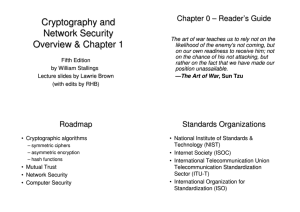

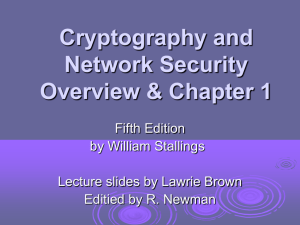

![Systems Assurance [Opens in New Window]](http://s3.studylib.net/store/data/007522633_2-e364c8f93e26286779d02c826b323ed6-300x300.png)
